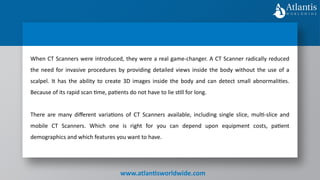Choosing A CT Scanner by Atlantis Worldwide
- 1. Choosing A CT Scanner By: Vikki Harmonay www.atlantisworldwide.com
- 2. www.atlantisworldwide.com When CT Scanners were introduced, they were a real game-changer. A CT Scanner radically reduced the need for invasive procedures by providing detailed views inside the body without the use of a scalpel. It has the ability to create 3D images inside the body and can detect small abnormalities. Because of its rapid scan time, patients do not have to lie still for long. There are many different variations of CT Scanners available, including single slice, multi-slice and mobile CT Scanners. Which one is right for you can depend upon equipment costs, patient demographics and which features you want to have.
- 3. www.atlantisworldwide.com Single Slice CT Scanners VS Multi Slice CT Scanners Single slice scanners were the first to be developed. They provide one image per rotation of the gantry, which is the ring the patient is placed within. A multi-slice CT Scanner allows for faster image acquisition because it provides more images per rotation. More images make scanning faster, which is great when you are examining weak elderly patients who canŌĆÖt lie still for long periods of time as well as unruly children.
- 4. www.atlantisworldwide.com Multi-slice devices are available in 16, 32, 40, 64, 320 and 256 slice configurations. More slices enhance your diagnostic capabilities and increase the range of applications. A 16-slice CT machine is capable of performing a wide variety of complex and sophisticated imaging procedures. It provides high resolution imaging with full organ coverage. However, itŌĆÖs not ideal for detailed cardiac analysis like coronary vessel analysis. For reduced likelihood of motion artifacts, a 32-slice CT Scanner is great. It requires shorter examination time than a 16-slice machine.
- 5. www.atlantisworldwide.com For cardiac studies, the 64-slice CT Scanner is recommended because it has significantly improved CT Angiography. Physicians are able to see how well the heart is contracting and can view artery walls for plaque formation. They can also observe the tiniest arterial branches and vessels and produce incredibly sharp images of the finest details. Scan time is also drastically reduced when compared to 16-slice machines. Many cardiologists still insist that the 64-slice scan is adequate for cardiac imaging and doesnŌĆÖt warrant the higher cost for the higher slice systems. ŌĆ£I donŌĆÖt see a clinical need for a 320- or 256-slice scanner right now,ŌĆØ said James Min, M.D., director of the cardiovascular CT lab at New York Presbyterian Hospital and assistant professor of radiology at Weill Cornell Medical College. ŌĆ£I think we are looking at a three- to five-year process before the incremental benefit justifies the increased cost.ŌĆØ
- 6. www.atlantisworldwide.com Mobile CT Scanners Mobile CT Scanners are ideal for use in remote locations without fixed CT Suites. A mobile machine is also perfect if your current CT Suite is being renovated or repaired. If you have multiple locations, you can also use a Mobile CT Scanner to travel between them, rather than investing in CT Scanners for each location. Length Of Coverage Another feature to consider is the length of coverage in one rotation of a CT Scanner. The rotation time of the tube and the detectors surrounding a patient (gantry rotation time) effects overall scan time.
- 7. www.atlantisworldwide.com The speed of image construction also differs between types of CT Machines. If patient throughput is delayed by slow image reconstruction, having more slices isnŌĆÖt beneficial. Purchasing a high specification computer is only worth it if itŌĆÖs going to be well utilized. CT Scanners with thinner and more slices in one rotation can handle more complex exams and diverse patient populations. CT Scanners can achieve rotation times of less than 0.3 seconds, but fast rotations like these are better used for specialist studies like cardiac scanning. This minimizes image artifacts cause by the motion of a heart.
- 8. www.atlantisworldwide.com ItŌĆÖs also important to consider how images will be manipulated, interpreted and also managed. Facilities may choose to have advanced 3D CT computer applications to use for manipulating and reading images. There are varying kinds of image storage as well, including hard copy archiving, electronic data storage or a full PACS electronic workflow.
- 9. www.atlantisworldwide.com Talk To An Expert There are many different considerations when choosing a CT Scanner for your healthcare facility. Another question is whether you want to purchase a brand new CT Scanner or if a refurbished or used system will provide you with the performance you want, but at a lower cost. Talk to the experts at Atlantis Worldwide for insights and recommendations. Contact Us Today!
- 11. Contact Us 60 East 42nd Street, Suite 4600, New York, NY 10165 Phone: 1-212-366-9100 Toll Free: 1-800-533-3356 Fax: 646-762-6562 info@atlantisworldwide.com https://www.atlantisworldwide.com https://info.atlantisworldwide.com/blog











